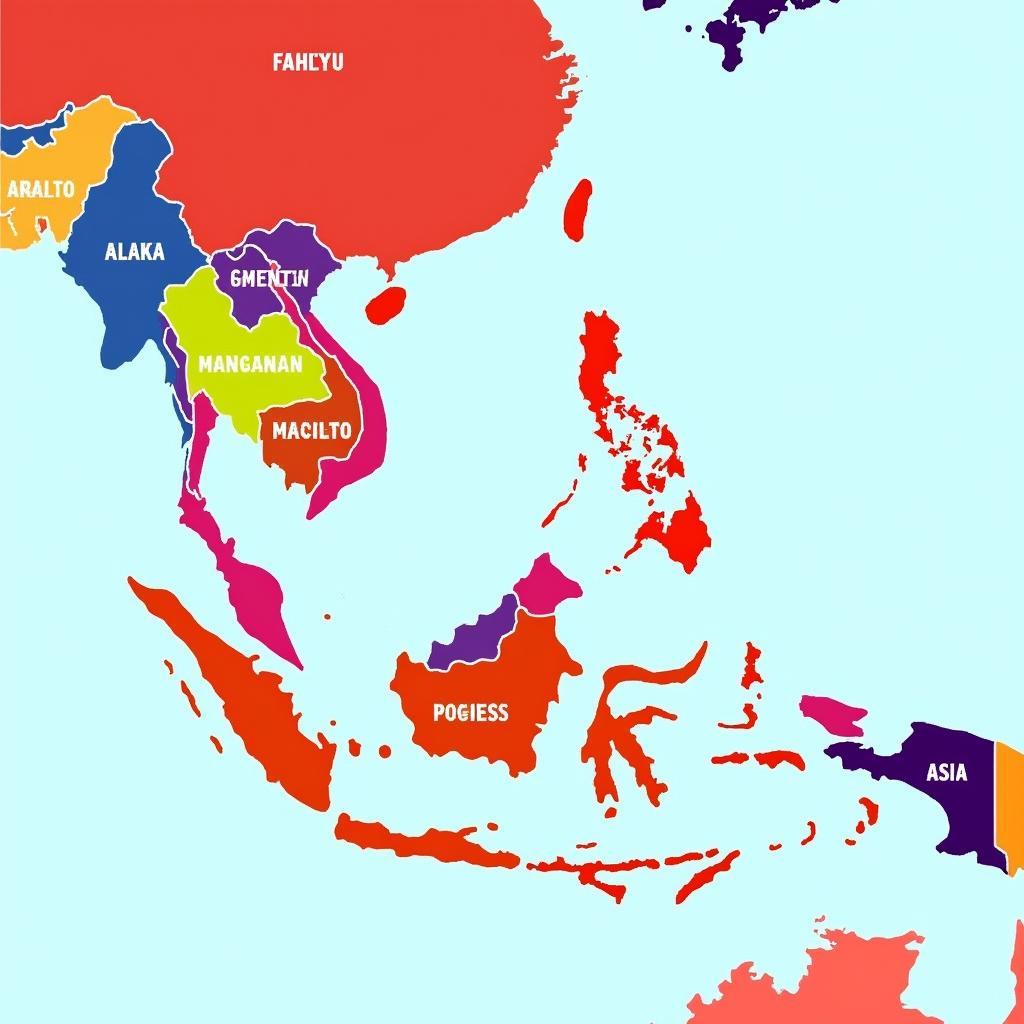The Association of Southeast Asian Nations, or ASEAN, is a political and economic union of 10 member states in Southeast Asia. These countries are Brunei, Cambodia, Indonesia, Laos, Malaysia, Myanmar (Burma), the Philippines, Singapore, Thailand, and Vietnam.
 Map of ASEAN Countries
Map of ASEAN Countries
A Closer Look at ASEAN Countries
Each ASEAN member state boasts a unique blend of culture, history, and natural beauty. Let’s take a closer look at what makes each country distinct:
- Brunei: Known for its opulent mosques and stunning Islamic architecture, Brunei is a small but wealthy nation on the island of Borneo.
- Cambodia: Home to the magnificent temples of Angkor Wat, Cambodia offers a captivating glimpse into ancient civilizations and a resilient spirit.
- Indonesia: The world’s largest archipelago, Indonesia is a vibrant tapestry of over 17,000 islands, each with its own unique culture and traditions.
- Laos: A landlocked country known for its laid-back atmosphere, Laos boasts serene landscapes dotted with Buddhist temples and traditional villages.
- Malaysia: From bustling Kuala Lumpur to idyllic beaches, Malaysia offers a fascinating mix of modern cityscapes and natural wonders.
- Myanmar: A country steeped in history and spirituality, Myanmar (formerly Burma) is home to breathtaking pagodas, ancient cities, and diverse ethnic groups.
- The Philippines: Comprising over 7,000 islands, the Philippines captivates with its pristine beaches, lush rice terraces, and vibrant culture influenced by Spanish and American history.
- Singapore: A bustling city-state at the forefront of innovation, Singapore is a global financial hub renowned for its futuristic architecture and efficiency.
- Thailand: From the majestic Grand Palace in Bangkok to the idyllic islands of the south, Thailand offers a captivating blend of history, culture, and natural beauty.
- Vietnam: Known for its breathtaking landscapes, from the rice paddies of the Mekong Delta to the towering peaks of Sapa, Vietnam also boasts a rich history and delicious cuisine.
Why are ASEAN Countries Important?
ASEAN countries play a significant role in the global economy and international relations. Here’s why:
- Economic Powerhouse: ASEAN has emerged as a major economic force, with a combined GDP exceeding $3 trillion. The region’s strategic location and abundant resources make it a vital hub for trade and investment.
- Geopolitical Significance: Positioned at the crossroads of major shipping lanes, ASEAN countries hold strategic importance in global trade and security. The region’s growing influence has attracted the attention of major powers seeking to strengthen ties and partnerships.
- Cultural Diversity: ASEAN is a melting pot of cultures, languages, and religions. This rich tapestry of diversity fosters creativity, innovation, and a vibrant exchange of ideas.
ASEAN’s Role in the World Today
ASEAN plays a crucial role in promoting peace, stability, and economic growth in the region and beyond. Here are some key areas where ASEAN is making a difference:
- Regional Cooperation: ASEAN fosters cooperation among its member states in areas such as trade, investment, security, and cultural exchange.
- Economic Integration: ASEAN is working towards creating a single market and production base through initiatives like the ASEAN Economic Community (AEC).
- Global Partnerships: ASEAN actively engages with dialogue partners and international organizations to address global challenges such as climate change, terrorism, and pandemics.
What is the Future of ASEAN?
ASEAN countries are poised for continued growth and development. The region faces challenges such as income inequality and political tensions, but its commitment to cooperation and integration offers a promising path forward.
FAQs about ASEAN Countries
1. What is the main goal of ASEAN?
The main goal of ASEAN is to promote economic growth, social progress, and regional peace and stability among its member states.
2. What are some of the challenges facing ASEAN countries?
Some challenges facing ASEAN countries include income inequality, political tensions, environmental degradation, and the impact of climate change.
3. How does ASEAN benefit its member states?
ASEAN benefits its member states by promoting economic integration, fostering regional cooperation, and enhancing their global standing.
4. What are some examples of ASEAN’s success stories?
ASEAN’s success stories include the establishment of the ASEAN Free Trade Area (AFTA), the creation of the ASEAN Economic Community (AEC), and its role in maintaining peace and stability in the region.
5. How can I learn more about ASEAN countries?
You can learn more about ASEAN countries by visiting the official website of the ASEAN Secretariat, exploring resources from reputable news outlets and research institutions, and engaging with cultural organizations that promote understanding of Southeast Asia.
Need Help Navigating the World of ASEAN Media?
Understanding the diverse media landscape of ASEAN countries can be challenging. If you’re looking for assistance, consider these resources available on Asean Media:
- ASEA Contactor EG 10: Discover valuable insights and information about ASEA Contactor EG 10.
- ASEA Magnetic Contactor: Explore a comprehensive guide to ASEA Magnetic Contactors and their applications.
- ASEA Drive Contactor: Find detailed information on ASEA Drive Contactors, including technical specifications and features.
For further assistance and inquiries, our dedicated team is here to help! You can reach us at 0369020373, email us at [email protected], or visit our office located in Ngoc Lien Village, Hiep Hoa, Bac Giang, Vietnam. We’re available 24/7 to provide comprehensive support and guidance.


